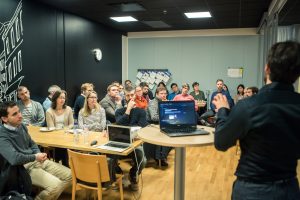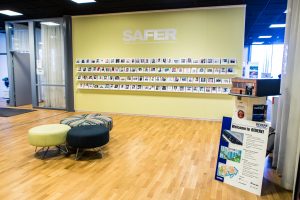Iris.ai and the Future of Science
After the initial launch of Iris.ai a lot of interested people have contacted us to find out more about our technology, our future roadmap and the impact we ambition to generate in the world. One of them was our friend from Chalmers University of Technology Christian Berger, Associate professor in Software Engineering at the Computer Science and Engineering Department. Christian invited us to talk about Iris.ai and the future of science with the researchers of his research group.
After a brief presentation, there was an interesting discussion about the daily problems faced by researchers and how much time is wasted doing mapping studies and literature reviews. Talk participants conveyed their fear that even after a couple of months of work there is still no guarantee that the discovered results will cover all the relevant research on any given topic.
A mapping study is important for every research group because it maps all the research within a certain topic and is used for identifying blank spots. These blank spots are areas where new research and innovation is needed. Research mapping studies go over 4-5 years of research and try to direct next steps towards filling the blank spots identified. The problem is that making a good mapping study takes months and there is no guarantee that it will be complete. Even if there are preexisting studies, most research groups still decide to complete their own.

During our visit at Chalmers we present the capabilities of Iris.ai and her expected contribution to solving that particular problem. We discussed that Iris.AI, by using her artificial brain, can read much faster and many more sources in no time, presenting to users what she thinks is the relevant landscape around a research topic.
Iris.ai is still a young AI, and she is not there yet in terms of being able to make a full and complete mapping study, but as everyone in the room agreed, she has the potential to make as good a job, or even a better one than a human, saving a lot of time in the process; time that can be used by researchers doing what they are best at: conducting new research. As much as people are interested in what has been done previously, studies show that only 5 to 10% is relevant to specific individuals in their particular area of research. This makes mapping studies not that exciting for the researchers currently tasked with making them.
Another interesting organization full of researchers that want to make our world a safer place was interested in the future of science and how we, as human beings, can make the research process sustainable, more efficient and faster. This organization is called SAFER.
SAFER, Vehicle and Traffic Safety Centre at Chalmers, is a competence center where 34 partners from the Swedish automotive industry, academia and public authorities cooperate to make a center of excellence within the field of vehicle and traffic safety. SAFER is located in Lindholmen Science Park, in Gothenburg, and provides excellent multidisciplinary research and collaboration to eliminate fatalities and serious injuries. They have the goal of supporting the Swedish government achieve zero fatalities caused by traffic accidents.

Presenting at their weekly seminar, and as CTO, I led the product demonstration of Iris.AI focusing on her capabilities of grasping the science around one of the audience’s favorite TED Talks – a talk by Chris Urmson: “How a driverless car sees the road” – in just a few seconds.
The audience expressed concerns about how much time is currently spent on making literature reviews and finding connections between research studies in different areas, in order to find a solution to such an interdisciplinary problem as safety on the road. And as some of the people from the audience pointed out, time spent is important because in this particular context safety means lives.
The discussion went into the direction of locating where are the inefficiency spots in the current research process. One of the problems raised was that in the process of researching a topic there is a lot of work that is done several times, inefficiently, until this research finally reaches end users. And one such work package is the literature review.
This literature reviews are conducted by the researchers who do the initial work, by researchers who follow-up, by entrepreneurs and managers at innovation departments who want to check whether implementation is feasible, and, lastly, by corporate development managers when it comes to implementation of the work.
We got positive feedback that the technology we are developing at Iris.AI could help drive more efficient innovation processes. Maybe at the beginning we can do that just by focusing on reducing the workload for people who do not need to go deep into scientific detail, such as entrepreneurs, innovators and corporate development managers, but at later stages we also plan to help interdisciplinary researchers spend less time on work that has already been done by someone else.
We are very glad to meet so many people interested in the future of science, and to be able to engage with them discussing its challenges openly. At Iris.AI we are well aware that we alone will not solve any of the problems currently faced by science. Instead, we want to talk with more and more people about those problems, raising researchers’ awareness and striving towards co-creating solutions with the research community. We also are very happy to see that other people, and researchers in particular, appreciate the potential of our little Iris.AI.
We believe that science is a critically important building block of our society, and making its processes more efficient will help bring forward the solutions to a lot of other pressing global societal problems.